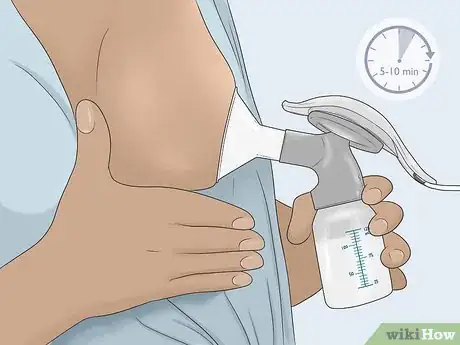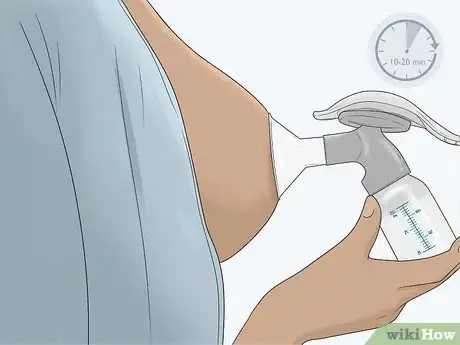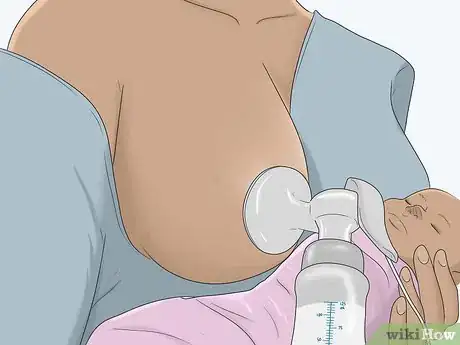This article was co-authored by Rebecca Nguyen, MA. Rebecca Nguyen is a Certified Lactation Consultant and Childbirth Educator. She runs Family Picnic in Chicago, Illinois with her mother Sue Gottschall, where they teach new parents about childbirth, breastfeeding and child development and education. Rebecca taught preschool through 3rd grade for 10 years, and she received her Master’s Degree in Early Childhood Education from the University of Illinois in 2003.
This article has been viewed 23,010 times.
Breastfed babies may prefer one breast over the other, which can lead to an imbalance in breast milk production. This may due to something simple, such as the comfort of a breastfeeding position or the milk letdown of that breast. Although it’s common for one breast to produce more milk than the other, there are some things you can do to increase the milk supply in the lower producing breast. Start by encouraging your baby to nurse more on the lower producing breast. You can also pump to increase your milk supply in that breast. Make sure to watch for potential problems and see a doctor if you have concerns.
Steps
Nursing to Increase Supply on One Side
-
1Offer the lower producing breast at the beginning of each feeding. Do this for 3 to 5 days to increase milk production on the lower producing breast. Babies often nurse more rapidly and deeply from the first breast they are offered, so offering the lower producing breast first may be enough to stimulate more milk flow in that breast.[1]
- For example, if your right breast is producing less milk than your left breast, offer the right breast at the beginning of each feeding. Then, switch to the left breast when the right breast is empty.
- If your baby only nurses from 1 breast during a feeding, then offer your baby the lower producing breast twice as often as the higher producing breast. For example, if the left breast produces less than the right, feed your baby from the left breast for 2 feedings and then the right breast for 1 feeding, then the left for 2 feedings again, and so on.
-
2Try different positions to help your baby feel more comfortable. If your baby seems uncomfortable nursing on one side and they get fussy or refuse to nurse on the other side, then you might also try different positions. This may help to make your baby feel more comfortable and encourage them to nurse more on the lower producing side. Some positions to try include:[2]
- Cradling your baby in your arms in front of you so that their body is facing yours.
- Holding your baby under the same arm as the breast you’re nursing them from so that they’re facing upwards. This is also known as the football hold.
- Lying on your back with your baby lying face down on your stomach and chest.
- Lying in bed on your side with your baby laying on their side and facing you.
Advertisement -
3Switch your baby between breasts several times during a feeding. Try switching your baby back and forth between your breasts every 3 to 5 minutes to encourage them to nurse more vigorously. Allow your baby to nurse longer on the lower producing breast than on the higher producing breast. This may help to encourage your baby to nurse more efficiently while also increasing the supply on your lower producing side.[3]
- For example, you could start with your lower producing breast, allow your baby to nurse for 5 minutes, switch to the higher producing breast for 3 minutes, then go back to the lower producing breast for 5 minutes, and so on.
Tip: If your baby dislikes being turned on one side to nurse, keep them in the same position when you switch breasts, such as by using the cradle hold while your baby nurses on the right breast and then transferring them to the left breast using the football hold.
-
4Massage your breast while your baby nurses to speed up the flow. If your lower producing breast has a slow let down, this may discourage your baby from nursing. Try gently massaging your breast to increase the flow while your baby nurses. Press on the breast tissue with your thumb starting near your armpit and move your thumb down towards your nipple. Then, repeat this motion on other areas of your breast while your baby nurses.[4]
- You can also stimulate the nipples by gently stroking the sides of your areola while your baby nurses.
Pumping to Increase Supply
-
1Pump the lower supply breast for 5 to 10 minutes every other feeding. Since breastfeeding is based on supply and demand, pumping can also help to increase your supply in one breast. Try pumping for 5 to 10 minutes after every other feeding during the daytime.[5]
- For example, if you breastfeed at 8:00 am and 10:00 am, pump after the 10:00 am feeding.
Tip: While some people might think that pumping less often will result in more milk, it’s just the opposite. The more you pump, the more milk your body makes.
-
2Add an additional 10 to 20 minute pumping session in between feedings. By doing an additional pumping session on the breast that is producing less milk, you may be able to stimulate that breast to produce more milk. Pump for 10 to 20 minutes on the lower producing side in addition to your normal pumping schedule.[6]
- For example, if you normally pump at 11:00 am, 3:00 pm, and 8:00 pm, try adding a session at 5:00pm where you only pump on the lower producing side.
-
3Pump after each feeding if your baby won’t nurse. If your baby refuses to nurse on the lower producing side, you can remove the milk with a breast pump and increase your supply on that side by pumping after each feeding. Don’t skip pumping after a feeding as this may result in an even lower production of milk.[7]
- For example, if your baby feeds exclusively on your right side and your left side is under-producing, pump on your left side after every feeding.
-
4Relieve the pressure on the higher producing breast when needed. It’s important to keep up with your normal pumping schedule if you are separated from your baby for long periods, such as while you’re at work. However, avoid increasing the amount that you pump on the side that is already producing enough milk. Instead, only pump that side when it is uncomfortable or at the times that you normally would. Don’t add extra pumping sessions on this side.[8]
- For example, if your right side produces enough milk, don’t pump on this side unless you need to remove the milk, such as to relieve the pressure if it’s uncomfortably full.
Watching for Potential Problems
-
1Call your baby’s pediatrician if your baby refuses to nurse on one side. If your baby always refuses to nurse on one side, take them to your pediatrician for a thorough exam. An issue caused during birth may have gone undetected and this might cause a baby to refuse to nurse on one side. It is also possible that your baby is refusing due to an ear infection or another ailment that is causing discomfort.[9]
- For example, if your baby cries, wiggles, or simply refuses to nurse on one side, they might be in pain in that position.
- If your baby recently had a vaccination, the injection site might be sore and this may cause them to refuse to nurse on that side.
-
2Check your breasts regularly for signs of an infection or mastitis. Mastitis is caused by a plugged duct, which can happen if one breast isn’t emptied as often as the other one. Call your doctor if you spot any symptoms of mastitis so that you can begin treatment right away. Treatment includes antibiotics, but you may continue to breastfeed your baby while you recover. Symptoms of mastitis to watch for include:[10]
- Breast tenderness or warmth
- Swelling of the breast
- A lump or thickened area of the breast tissue
- Pain or a burning sensation while breastfeeding
- Redness of the breast that sometimes appears in a wedge shape
- A fever of 101 °F (38 °C) or higher
- A general feeling of unwellness
-
3Meet with a lactation consultant if you continue to have problems. If you can’t seem to even out the supply in your breasts, you may benefit from a consultation with a lactation specialist. They can teach you techniques and provide personalized guidance to help you increase your supply in one breast. Ask your doctor or your baby’s pediatrician for a referral.[11]
Tip: Keep in mind that seeing a lactation consultant might not be covered by all forms of health insurance. Check with your insurance company before you make an appointment.
Expert Q&A
Did you know you can get expert answers for this article?
Unlock expert answers by supporting wikiHow
-
QuestionHow can I increase my milk supply in one day?
 Rebecca Nguyen, MARebecca Nguyen is a Certified Lactation Consultant and Childbirth Educator. She runs Family Picnic in Chicago, Illinois with her mother Sue Gottschall, where they teach new parents about childbirth, breastfeeding and child development and education. Rebecca taught preschool through 3rd grade for 10 years, and she received her Master’s Degree in Early Childhood Education from the University of Illinois in 2003.
Rebecca Nguyen, MARebecca Nguyen is a Certified Lactation Consultant and Childbirth Educator. She runs Family Picnic in Chicago, Illinois with her mother Sue Gottschall, where they teach new parents about childbirth, breastfeeding and child development and education. Rebecca taught preschool through 3rd grade for 10 years, and she received her Master’s Degree in Early Childhood Education from the University of Illinois in 2003.
International Board Certified Lactation Consultant
References
- ↑ https://kellymom.com/bf/got-milk/lopsided/
- ↑ https://kellymom.com/bf/got-milk/lopsided/
- ↑ https://www.breastfeeding.asn.au/bf-info/common-concerns%E2%80%93mum/supply
- ↑ https://www.breastfeeding.asn.au/bf-info/common-concerns%E2%80%93mum/supply
- ↑ https://kellymom.com/bf/got-milk/lopsided/
- ↑ https://kellymom.com/bf/got-milk/lopsided/
- ↑ https://kidshealth.org/en/parents/breastfeed-supply.html
- ↑ https://kellymom.com/bf/got-milk/lopsided/
- ↑ https://kellymom.com/bf/got-milk/lopsided/







































































